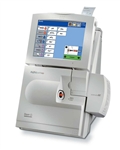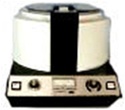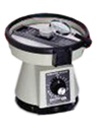Description
The Siemens Advia 2120 hematology analyzer – This bench-top analyzer designed for medium- to large-volume laboratories, uses a combination of light scatter, cytochemical staining, and nuclear density on two independent channels to measure the total and differential white cell counts. The flow cytometry-based system utilizes peroxidase staining – the gold standard for differential testing. Operating with a cyanide free method for hemoglobin measurement, the analyzer features a new user interface. The Advia 2120 system can routinely analyze biological fluid samples in addition to blood.
- Parameters: 30: 5-pt Differential
- Throughput: 74-120 samples/hour
- Method: Volume Impedance
- Open system: Open
- Reduces manual operator intervention
- Improves turnaround time
- Dual technology provides accurate, specific flagging that lowers manual review rates
- Reduced differential reject rates
- Specific cytochemical differentiation of myeloid and lymphoid cells
- Diagnostic cytograms assist with rapid diagnosis and result validation
- Unique six-parameter differential with LUC population provides additional clinical information
- Accurate differentials on leucopenic and aged samples
- Extended linearity of 400 x 1000/µL minimizes the need for dilutions
Advia 2120 bench top analyzer uses a combination of light scatter, cytochemical staining, and nuclear density on two independent channels to measure the total and differential white cell counts. Standard testing methodology in this system provides optimum results and offers flexibility and simplicity for easy integration in labs for 30 parameters with 5 part differential analysis. Operating with a cyanide free method for hemoglobin measurement, the analyzer features a new user interface.
Features Of Siemens Advia 2120 Hematology Analyzer
- Throughput of 74-120 samples / hour
- Gold-standard flow cytometry peroxidase methodology
- Reduced differential reject rates
- Unique six-parameter differential with LUC population provides additional clinical information
- Extended linearity of 400 x 1000/µL minimizes the need for dilutions
- Dual technology provides accurate, specific flagging that lowers manual review rates
- Diagnostic cytograms assist with rapid diagnosis and result validation
- Accurate differentials on leucopenic and aged samples
- Specific cytochemical differentiation of myeloid and lymphoid cells
Siemens Healthineers, a leading global healthcare company, is creating history with the development of a rapid blood test for malaria. Malaria is a life-threatening mosquito-borne blood disease caused by a Plasmodium parasite. Though eliminated from the United States in the early 1950s, approximately 1,700 cases of malaria are reported every year in the U.S. According to the report from WHO, there were 212 million new cases of malaria worldwide in 2015 (range 148-304 million).
Siemens Healthineers hematologist Jan van den Boogaart and his Austrian research colleague Prof. Oliver Hayden (who earlier worked at Siemens Healthineers), has developed the first automated, computer-based blood test for malaria. Combining medicine and information sciences, the test is based on a computer algorithm that detects infections with unprecedented accuracy. The European Patent Office has honored these inventors with the 2017 European Inventor Award. The technology is based on a conventional hematology analyzer, specifically Siemens’ Advia 2120 system, a high-throughput system for complete blood count and the differentiation of blood cells.
Instead of looking for the presence of malaria pathogens in the blood, they used information technology to detect the disease’s damaging effects, as indicated by key blood parameters such as lowered platelet counts. Previous detection methods for malaria include a time-intensive microscopic procedure that requires a technician working roughly an hour in the lab or a dip-and-react test for malaria antigens.
Linear discriminant analysis (LDA), a statistical method was used for the new discovery. The scientists ran a statistical analysis of the blood parameters of the malaria samples and non-malaria samples. This data formed the basis for defining a set of 30 parameters that indicate a malarial infection – including the density of red blood cells, as well as levels of the blood-coloring agent hemoglobin – and the percentage deviation from healthy levels needed to signal a “positive”.
An algorithm was developed to program malaria’s “data fingerprint” into the Siemens ADVIA 2120i hematology analyzer. Widely used in clinics, this automated hematology analyzer can create hemograms with 300 to 500 parameters at the rate of 120 blood samples per hour. With near-100% accuracy, the system identifies malaria in a blood sample even if only low levels of pathogens are present.
The great advantage is the high throughput at lower cost compared to other methods such as microscopic examination. Hayden says, “For such conditions, I believe this algorithm would be very interesting because you can screen the patients on the mass level and it fits also very nicely in a central lab environment. Currently, the test remains a research product and the patent and rights to the technology belong to Siemens.” The team’s test could also improve outcomes for travelers from Western countries returning home infected with malaria.





Reviews
There are no reviews yet.